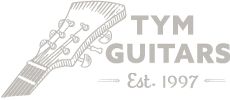1966 Teisco TG-64
Share
By the time the TG-64 came along in 1964 Teisco were no stranger to the "monkey grip" in the body. The (now) famous T-60 was first produced in 1960 and although it was a different shape, it had the monkey grip cut in the body. The T-60 was to be made famous by one Glen Campbell who favoured one over bigger brands in the early 60's.
The T-60 was a solid body "offset" influenced guitar with a set neck and 3 Teisco pickups. Early ones (like Glens) also had a monkey grip in the headstock as well, which was dropped on later versions and wouldn't carry over to the 64.

The TG-64 first appeared with all the trimmings of the other early/mid 60's Teiscos of the day with a blank aluminium scratchplate and early plate style vibrato initially, however it was introduced with the new 4/2 headstock, originally with a more Fender round end, and then quickly moved to the more common "hook" end, but never carried the 6 a side from previous models. The scratchplate was always a two piece with the control part being black anodised aluminium with a few (very) rare ones having black pickup plates as well. Early versions and the bass (more on that soon) had the volume knob on the big pickup scratchplate and the tone and output jack on the small control plate.
I have owned a few of these over the years and they're always quite weighty, but this one is down right heavy. I've never been able to definitively work out what the body timber is, and they're a big body, but this one is heavy.

Having said that, they are VERY comfortable to play, and the shape is one of my favourite offset influenced guitar designs. The slightly longer, more pronounced top horn, with the nice contour makes the guitar different enough from a JM/Jag shape and of course the monkey grip really sets it apart from almost everything else.
The bolt on neck is the same as most Teiscos from this period and feels VERY comfortable. It's a 24.75" scale which is of course between a Jag and a JM.and feels good on this shape.

The 4/2 headstock is a classic design now and I've always loved headstock plates, especially on these. It really sets that headstock shape off nicely.
This one is from the transition period of changing over from the plate style vibrato to the new more common Teisco unit and has the white "mistake plate" (as Semie lovingly called them) to cover the hole from the old vibrato unit. This plate didn't last long and some were fitted with (black plastic/rubber) plugs until the new bodies were made without these holes. Some slightly later ones also had the horizontal spring/cover type vibrato as used on the WG series but not many of these have surfaced.

As I've mentioned before I really like these pickups, a lot. They have a solid mid range not unlike a P-90 but with a good top end sparkle like a Fender single coil. The switching is typical of the period with ON/OFF rockers for each pickup and a lead/rhythm slider switch combined with a master volume and tone control. This gives an amazing array of options and tones.
These were sold in the US as the Teisco Del Rey Model ET-320, and also under the very rare "Rhythm Beat" brand, both of which were the same guitar with the importers brand name on the headstock. This model was also available in a bass version, complete with monkey grip, under the model name TB-64, which all seem to have the more "Fenderish" 4/2 headstock with, and without the vibrato although vibrato equipped ones are rare indeed.

By this period Teisco were making good quality guitars, and during the mid 60's a lot of the Japanese manufacturers were trying new ideas and designs. By '66/67 some of the shapes and ideas coming out of Japan were .... amazing. While this design is heavily influenced by Fender, especially the offset, it has enough interesting design features to set it apart from it's influence.

This one plays great and sounds really good, especially with the tonal choices available from 3 pickups and the switching available. The neck is really nice and apart from it being heavy, is something that I would play live without a second thought.











